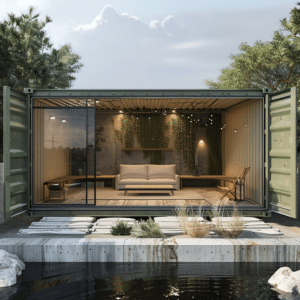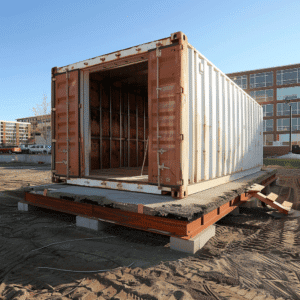Just as a tree needs strong roots to withstand the elements, so too does a shipping container require a foundation for stability.
You might be wondering, ‘Do shipping containers really need a foundation?’ The answer is yes, but it’s not as simple as you think.
The type of foundation you choose can drastically influence the performance of your container. By the end of this discussion, you’ll have a much clearer understanding of why foundations are not just an afterthought, but a critical aspect of container installations.
The Importance of Foundations
Without a proper foundation, your shipping container may sink, tilt, or shift over time, compromising the structural integrity and safety of the building. It’s not just about keeping your shipping containers level; it’s about ensuring they’re able to withstand heavy loads, weather conditions, and even hurricanes – as well as the test of time.
A container foundation provides the necessary support, anchoring your containers firmly to the ground. This is particularly important when using multiple shipping containers for a larger structure. Without a solid foundation, you’re likely to encounter structural problems down the line.
Permanent foundations, while more resource-intensive, offer the greatest stability and longevity. They’re designed to evenly distribute the weight of the container, preventing sinking and shifting. They also provide an extra layer of protection against water damage and pests.

Choosing the Right Place for Your Containers
Once you’ve understood the importance of a solid foundation, the next step is to carefully select the exact spot where your shipping containers will sit. It’s not a decision to be made lightly; the location you choose can impact the stability and longevity of your shipping container.
Look for level ground. This is crucial in ensuring your container is stable and safe. If the ground isn’t level, it can cause your container to tilt or sink, potentially damaging your goods or making the container unsafe to enter. Use a container level to check the ground is flat before placing your container.
Avoid areas prone to flooding or with poor drainage. Water pooling around your container can lead to corrosion and damage the foundation for your shipping container. Similarly, avoid areas with loose or sandy soil as they may not provide a stable enough base.
Different Types of Foundations for Shipping Containers
Now let’s dive into the different types of foundations you can consider for your shipping containers. There are several methods, but we’ll focus on four main types: concrete slab, pier, pile, and strip foundations.
A concrete slab foundation is often used for shipping container foundations. It’s a flat, horizontal surface made of concrete. You’ll appreciate its durability and stability, especially if you’re planning to stack your containers. However, it can be costly and time-consuming to install.
Pier foundations, on the other hand, are more economical. They involve placing the container on a series of concrete or steel piers, distributing the weight evenly. This option is ideal if you have a sloping site or poor soil conditions.
Pile foundations are similar to pier ones, but they’re driven into the ground. These are great for unstable soil conditions and can provide excellent support for your container.
Lastly, strip foundations are used when you’re placing your container on a flat surface. They’re made of a continuous strip of concrete, providing uniform support along the entire length of the container.
Temporary Foundations
While those were permanent solutions, you may also want to consider temporary foundations for your shipping container if you’re not anticipating a long-term stay. Temporary foundations are generally more cost-effective and quicker to install than their permanent counterparts.
These types of foundations typically consist of railroad ties, concrete blocks, or even just a flat piece of ground. The primary purpose of a temporary shipping container foundation is to level and stabilize the container structure. This ensures that your container is safe and operational, even if it’s not at ground level.
Avoid prolonged ground contact with your container as it can lead to corrosion and damage. By using a temporary foundation, you’re lifting the container off the ground, which allows for better air circulation and prevents moisture from accumulating.
Permanent Foundations
If you’re planning for a long-term placement of your shipping container, opting for a permanent foundation becomes crucial. This type of foundation provides the necessary stability, durability, and longevity that temporary foundations can’t offer.
A popular choice for permanent foundations is the concrete foundation. There are several types of concrete foundations you can use. All are sturdy, reliable and can withstand heavy loads and adverse weather conditions. Concrete slab foundations, a subtype of concrete foundations, involve pouring a thick layer of concrete onto the ground. They’re typically used for shipping container homes, providing a flat and even surface that’s perfect for container placement.
Another type of permanent foundation is the footing foundation. This involves digging holes into the ground, filling them with concrete, and placing the container on top. It’s an excellent choice if you’re dealing with uneven terrain or soft soil. With footing foundations, you’re ensuring that your shipping container is secure and won’t sink over time.
Regardless of the type of permanent foundation you choose, it’s clear that investing in a solid base is paramount. It not only ensures your container’s stability but also contributes to its longevity, making it a worthy investment for your shipping container project.
Pile Foundations
In the realm of shipping containers, pile foundations can offer stability even in the face of challenging soil conditions or high wind loads. You’d find these types of foundations particularly useful when dealing with lower bearing capacity soil, which simply can’t support the weight of a shipping container on its own.
They’re designed to distribute the load of your container evenly, making them perfect for dealing with isolated point loads. Essentially, pile foundations work by driving cylindrical solid steel tubes deep into the ground until they reach a layer of soil with sufficient bearing capacity. The top of these piles, sticking out of the ground, is then used as the foundation for your shipping container.
Choosing a pile foundation means you’re not only reinforcing the structural integrity of your container, but you’re also ensuring that it stays put in adverse weather conditions. It’s a choice that manages risk and provides a solid base for your container, regardless of the ground it sits on. So, when you’re faced with poor soil conditions or high wind loads, you’ll find that pile foundations are a reliable, robust solution.
Pier Foundation
Moving on from pile foundations, let’s now turn our focus to pier foundations, another effective way to provide stability for your shipping container. When designing your shipping container house, you should consider a pier foundation as an option.
This type of foundation consists of large, sturdy pillars that are driven into the ground to support the weight of your container home.
The pier foundation is a cost-effective option that provides a solid foundation for your container. It’s especially effective if you’re situating your container home on sloping or uneven ground. When correctly installed, pier foundations evenly distribute the weight of your container, preventing any unwanted movement or shifting.
Choosing the right foundation is crucial to the lifespan and stability of your shipping container house, right next to insulation. With a pier foundation, you’ll benefit from its simplicity and durability. It requires less excavation and material than other foundations, which can reduce your overall costs.
Concrete Footing
Switching gears to concrete footing, it’s another reliable foundation choice you should consider for your shipping container house. Concrete footings provide a stable, durable base that can bear the weight of your container and protect it from ground movement, frost, and other elements.
The process of constructing a concrete footing involves digging a trench, then pouring concrete into it. The depth and width of the trench depend on the size and weight of your shipping container. It’s essential to get these calculations right to ensure your footing is strong enough to support your container.
Placing wet concrete in the trench forms the footing. It’s crucial to level the wet concrete as you pour it, ensuring an even and sturdy footing. This job requires precision, as any mistakes could affect the stability of your shipping container house.
Once the concrete footings are in place, they need to cure for several days before you can place your shipping container. Be patient, as rushing this process can compromise the strength and stability of your foundation.

Concrete Slab Foundation
Often, you’ll find that a concrete slab foundation is your best bet for a sturdy and resilient base for your shipping container home. This type of foundation creates a flat, smooth concrete floor upon which your container can sit securely. It’s not just about pouring concrete into a designated area; it’s a process that requires careful planning and execution.
First, you’ll need to prepare the site by marking out the area where you’ll pour the concrete. After that, you’ll need to excavate the area to remove any grass, plants, or other materials that could interfere with the concrete.
Once the site is prepped, you’ll lay down a layer of gravel to promote drainage and prevent any water-related issues down the line. Then comes the crucial part: embedding the reinforcing steel. This steel is crucial for enhancing the structure’s strength, ensuring that your foundation can bear the weight of your shipping container home.
The final step is to pour the concrete, smoothly spreading it over the area. It’s essential to get this part right, as a smooth concrete floor will ensure your container sits level, eliminating potential structural issues. When done correctly, a concrete slab foundation provides a durable, sturdy base for your shipping container home.
Concrete Strip Foundation
Another viable option for your shipping container home’s foundation is the concrete strip foundation. This type of foundation, also known as a trench foundation, involves digging a trench in the ground and filling it with concrete. It’s a cost-effective method for container foundations, which doesn’t require as much foundation material as other types.
The concrete strip foundation is perfect for uneven terrains. It adjusts to the topography, providing a solid base for your shipping container home. You’ll need to ensure the trench is deep and wide enough to support the weight of the container and that it’s properly leveled to avoid any future tilting issues.
One of the advantages of this foundation type is its ability to handle heavier loads compared to other foundation types. It’s also more resistant to soil movement and shifting, which can be crucial in areas prone to seismic activities.
Frequently Asked Questions
Does a shipping container need to be on a slab?
While a shipping container does not necessarily need to be placed on a concrete slab, using one can provide significant benefits, especially for long-term installations. A concrete slab foundation offers a robust barrier that protects the container from corrosion, ensures stability, and evenly distributes its weight.
However, the necessity of a slab or other types of foundations like wooden beams or concrete footings depends on the specific use case, ground conditions, and whether the container needs to be moved in the future. For temporary or mobile purposes, simpler foundations or even level ground might suffice, but for permanent structures, especially in variable climates or on unstable soil, a concrete slab can provide essential support and durability.
What is the best base for a shipping container?
The best base for a shipping container can vary depending on its intended use and location, but commonly recommended foundations include concrete slabs and pier supports. Concrete slabs provide a solid, stable platform that can protect the container from moisture and ensure it remains level and secure.
Pier foundations are also popular due to their cost-effectiveness, ease of installation, and suitability for various ground conditions. They allow for better airflow underneath the container, reducing the risk of corrosion. While gravel pads and wooden beams are options for less permanent setups or when budget constraints are a concern, concrete foundations are typically preferred for long-term or permanent container placements due to their durability and stability.
What is the best surface to put a shipping container on?
The optimal surface for placing a shipping container is a level, stable, and compact base to prevent shifting or tilting over time. Concrete slabs are highly recommended as they provide a solid and durable foundation, protecting the container from corrosion and ensuring it remains level.
Alternatively, footings foundations, which involve digging holes and pouring concrete, can offer stability, especially in rocky soil conditions. Other viable options include using pairs of bricks, cinder blocks, heavy-duty paving slabs, or even railway sleepers to support the container’s weight effectively. Ensuring proper ground preparation is crucial for the container’s longevity and functionality.
What does a shipping container need to sit on?
A shipping container needs to sit on a stable, level, and durable surface to maintain its structural integrity and prevent shifting or tilting. The best surface to put a shipping container on is typically a concrete slab, which provides a solid and enduring foundation. Concrete slabs help to distribute the container’s weight evenly, prevent moisture accumulation, and protect against corrosion.
Additionally, they facilitate easy access and use of the container. For temporary placements or when budget constraints exist, alternatives like gravel pads, railway sleepers, or even compacted earth can be used, provided they are level and properly prepared to support the container’s weight and prevent sinking.
Conclusion
Just like a house isn’t secure without a firm footing, your shipping container needs the right foundation too. Whether it’s a temporary base or a permanent concrete one, the choice depends on your specific needs.
Remember, laying down the right foundation is pivotal not just for the stability of your container, but also for its longevity. So, take the time to choose wisely, because the foundation is the unsung hero holding your project together.


